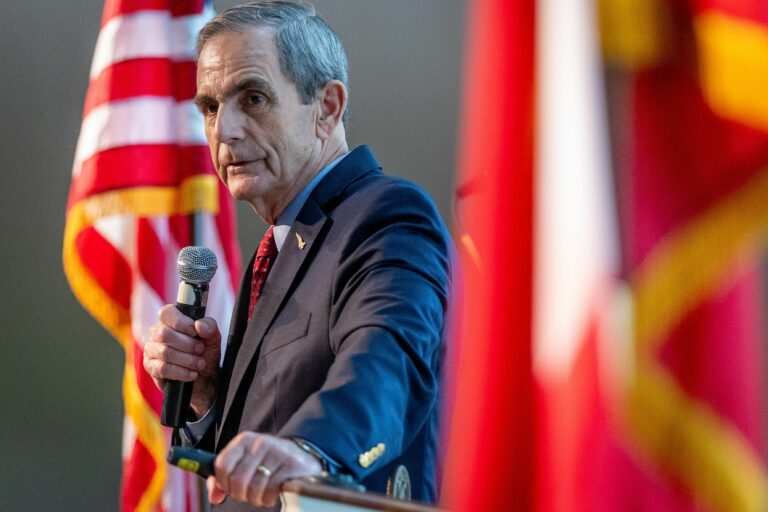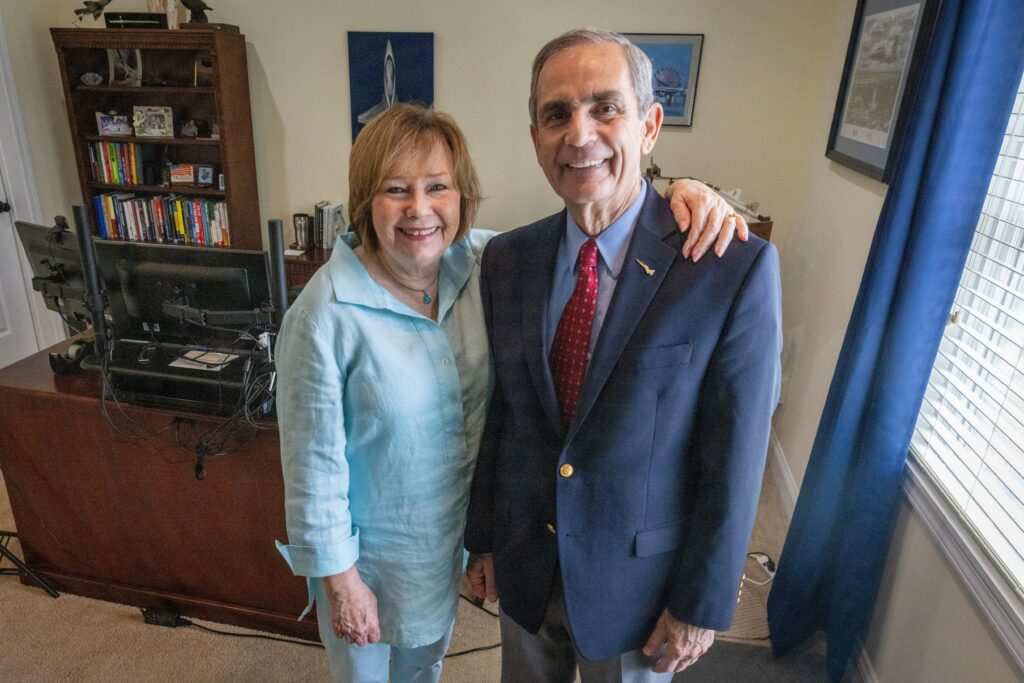
During the nearly five and half years he was held as a prisoner of war in Vietnam, Lee Ellis persevered by keeping his mind busy.
Between the boredom, deprivation and beatings, Ellis recited poems by Rudyard Kipling, Robert Service and Robert Frost. An airman from North Georgia, he memorized the names of more than 150 other POWs. In alphabetical order. From fellow American captives, he learned Spanish. And German.
In his imagination, Ellis operated a 40-acre farm. He designed and built the fences. Bought livestock. Calculated the costs for planting, fertilizing and harvesting the crops. Ellis concentrated on that fantasy for as many as 10 hours a day, sometimes so intensely that he gave himself headaches.
His ruminations transported him away from his cruel captors, the claustrophobic prisons and the oppressive heat.

Now 79, Ellis is celebrating the 50th anniversary of his freedom. He and his late friend John McCain were among more than 500 American POWs who were released during Operation Homecoming following the signing of the Paris peace agreement in January of 1973.
Being held captive for so long, Ellis has concluded, was a gift that helped him become a better man, a public speaker and an author. This year, he published a new book about his harrowing experiences, resiliency and relationships, “Captured By Love: Inspiring True Romance Stories from Vietnam POWs.”
“You have got to be positive. You have to believe in a good outcome. And you have to be willing to suffer to get there,” he said.
‘Hands up! Surrender! No die!’
The son of a farmer and a schoolteacher, Ellis graduated from Commerce High School and then the University of Georgia, where he participated in the ROTC program. He joined the U.S. Air Force as a second lieutenant and headed off to the Vietnam War.
As a fighter pilot, he protected U.S. soldiers and Marines on the ground and bombed enemy supply lines. He was on his 53rd mission when his luck ran out. The year was 1967. Ellis was 24.
Flying in a F-4C Phantom jet, Ellis and his aircraft commander were told to bomb an anti-aircraft gun protecting a North Vietnamese supply ferry on the Song Gianh River.
Tracer fire flashed up at them while they rolled in. After they had dropped their bombs and began to pull away, their plane exploded. It’s possible, Ellis said, that the fuses on the bombs his plane dropped malfunctioned, causing them to explode too soon and blow his jet out of the sky.
On fire, their plane flipped upside down. That pushed Ellis’ head up against the canopy, which was filling with smoke. Then the jet flipped again. Ellis had his chance. He yanked his ejection handle. Bingo. He shot out of his crippled jet about 2,000 off the ground.
Bullets whizzed by as he and his crewmate parachuted down. Ellis tried to guide himself toward the river, thinking he could make it to the ocean and then to the U.S. Navy. When he landed, he scampered into a waist-deep bomb crater and used his radio to call for help.
But it was too late. Rifle-wielding North Vietnamese militiamen quickly approached him. Ellis tried to scare them off with his pistol, firing a round over their heads. They didn’t flinch. Instead, one pulled out a card printed with instructions in Vietnamese and English and told him: “Hands up! Surrender! No die!”
They stripped him to his underwear, searched him and then returned his flight suit, though without his boots. Then they blindfolded him, bound his hands together and tied a rope around his neck. They used that rope to lead him.
Ellis thought about slugging his guard, grabbing his rifle and fleeing. He decided against that, concluding he would stand out in the populous countryside.
Eventually, Ellis was taken to a home, where he slept, still tied up, between his guard’s father and two-year-old daughter. The family fed him rice. He couldn’t use chopsticks, so he was given a spoon. They used sign language to communicate.
As they traveled from hamlet to hamlet, his captors repeatedly protected him from angry mobs, who sought to attack him with sticks and rocks. Ellis wasn’t surprised by their hostility.
“We were bombing them every day,” Ellis said. “I completely understood.”
He got a close-up view of the terror they experienced during his grueling two-week journey north, witnessing U.S. jets fly in low and attack trucks parked along the road. Chunks of red-hot shrapnel landed near him. During one such attack, his guards pushed him into an underground bomb shelter topped with dirt. Deafening blasts roared above them.
The pretzel torture
On the way to Hanoi, Ellis was interrogated, threatened and beaten. At a prison in Vinh, a guard jammed his rifle barrel against Ellis’ head and chambered a round.
A few months after he arrived at the Hoa Lo Prison — nicknamed the Hanoi Hilton — his captors ordered him to fill out a three-page biographical questionnaire. He refused and was ordered to remain for hours in a stress position with his knees on the ground and his arms raised in the air. He held that pose for as long as he could until it was too painful. He started shaking and fell over. His guards beat him until he got back into position.
“It made me feel worthless because I couldn’t beat them,” he said. “I wasn’t strong enough to beat them. I should be able to do this. Well, nobody could beat them.”
When Ellis and the other POWs refused to bow, their guards closed the air vents to their cell, where the temperature would reach 100 degrees Fahrenheit. The sweltering conditions caused them to suffer from heat rash and boils.
The worst treatment, Ellis said, was reserved for higher-ranking American officers. Some endured the brutal “pretzel” torture: Their legs were bound and their arms were tied behind them. Then the guards pressed their knees into the POWs’ backs and pushed their arms up over their heads.
Ellis was moved to a prison camp west of Hanoi called Son Tay. In November of 1970, U.S. Green Berets were sent on a daring mission to rescue the Americans held there. It was too late. The captors had moved the prisoners. But the raid prompted the North Vietnamese to consolidate many of the POWs at the Hanoi Hilton.
That allowed them to spend more time together in larger groups and in bigger cells, where they could commiserate and heal, Ellis said. Using broken bricks like chalk, they taught each other physics, calculus, history and poetry. Ellis saw the older American officers there as wise and courageous mentors. The time he spent with them helped him better understand himself and become more humble and authentic.
Peace talks had stalled in 1972. So President Richard Nixon ordered a massive bombing campaign against military targets in North Vietnam in December of that year. As part of Operation Linebacker II, American B-52s dropped more than 15,000 tons of bombs. The North Vietnamese government reported many people were killed or injured. Ellis saw fear in the eyes of his captors during the punishing attack. The bombings, he said, “forced them to turn us loose.”
The two sides signed a peace agreement in Paris on Jan. 27, 1973, leading to the POWs’ release. On March 14 of that year, Ellis, his aircraft commander, Ken Fisher, McCain and others boarded a flight out of Hanoi.
Ellis and McCain occupied neighboring cells at the Hanoi Hilton for 18 months. But they did not actually meet until later, when Ellis encountered the future U.S. senator and presidential candidate limping around a different Hanoi prison camp nicknamed the Plantation.
Initially during their flight to freedom, Ellis said, they remained calm and quiet. But when the aircraft commander announced they were over the ocean, and therefore out of enemy range, they giddily screamed and stomped. Ellis smoked a cigar and hugged the nurses on board.
“Everything was just so energetic,” he said, “so light.”
Nightmares
As a prisoner, Ellis suffered from nightmares in which he fought an endless procession of North Vietnamese soldiers, sometimes with guns and sometimes by hand.
“Eventually, I was too exhausted to keep fighting, and one of them would get me. As I lay dying, I would force myself to realize it was a dream and wake up,” he wrote in a book he published in 2012 about his experiences, “Leading with Honor: Leadership Lessons from the Hanoi Hilton.”
Ellis constantly watched out for guards so they wouldn’t discover him passing information to others. That hypervigilance lingered for some time after he was freed. So did his emotional flatness, something he practiced for his mental health as a POW. He tried not to get too high or too low.
Though he has never been diagnosed with post-traumatic stress disorder, Ellis wrote that he has experienced its symptoms, including unnecessary anger and an excessive need to be in control. Such symptoms, he said, have faded with time.
Ellis, who retired from the Air Force as a full colonel, received a Purple Heart, two Silver Stars and two Bronze Stars. He regularly speaks publicly about his experiences in the Vietnam War and about leadership and resiliency. Meanwhile, he is savoring his freedom.
In May, he and dozens of other former POWs were honored at a reunion dinner at the Richard Nixon Presidential Library and Museum in California. He was introduced on stage this year at the National Memorial Day Concert in Washington, D.C. And when he was interviewed on ABC World News Tonight about the 50th anniversary of his freedom, he demonstrated how he and the other POWs covertly communicated with each other through tapping.
“We all came home better men,” he said.
Finding ‘the one’
During the war, many of the POWs’ wives raised awareness about their plight and advocated for their humane treatment and release through the National League of POW/MIA Families.
“The loyalty and courage of these women is almost beyond belief,” Ellis wrote in his new book, “Captured By Love,” adding they “stood up, stepped up, and courageously led a battle that changed the politics of two nations at war.”
Ellis was single when he deployed to Vietnam. After he returned home, he met a woman — he called her “the one” — at an officers’ club at Moody Air Force Base near Valdosta. Mary was studying education at Valdosta State University. Ellis thought she was “absolutely beautiful.” They danced that night.
In some ways, they were opposites when they met. Ellis was an expressive extrovert. She was a quiet introvert. He was take-charge. She was cooperative. Yet, they clicked. In his new book, Ellis wrote about how they have made their marriage work with the help of patience and understanding. It also helped that they grew to share interests in psychology and coaching. She now works as a licensed professional counselor.
“I’m a good listener. And he is a good talker,” she said during an interview at their home in Dawsonville, adding it’s important for spouses to able to accept each other’s differences.
Ellis chimed in: “We both have been willing to grow and learn. Neither one of us said, ‘Well, that is just the way I am. I am never going to change.’ You do have to learn to adapt.”
Mary had two kids from her first marriage. She and Ellis had two more children together. Next year, they will celebrate their 50th wedding anniversary.
___
© 2023 The Atlanta Journal-Constitution
Distributed by Tribune Content Agency, LLC.
0 comments :
Post a Comment